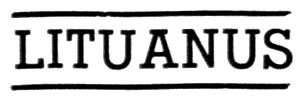
September, 1958 Vol. 4, No. 3
Managing Editor P. V. Vygantas
 |
www.lituanus.org |
| Copyright
© 1958 Lithuanian
Students Association, Inc. September, 1958 Vol. 4, No. 3 Managing Editor P. V. Vygantas |
|
V. K. JONYNAS
A MASTER OF WOOD ENGRAVING
ALEKSIS RANNIT
ALEKSIS
RANNIT, a founder member of the International Association of Art
Critics Paris, is author of a monograph on V. K. Jonynas published in
19Jt7 by Editions Arts et Sciences.
The true artist reveals himself in an
aesthetical struggle between his instincts and his equilibrium of
thought, between his biochemical physis and his education. Through this
struggle his individual style is formed. Vytautas Kazys Jonynas is one
of those creative personalities who are capable of transforming this
perpetual fight into plastic forms. He was submerged in the external
world until he learned to fight for his own inner one. Since then he
has been on guard to defend this internal world against the empirical
one.
V. K. Jonynas was born on March 16, 1907, In Ūdrija, in the county of
Dzūkija (southeastern Lithuania). He graduated from the Lithuanian
Gtate School of Art in Kaunas in 1927. In 1931 he went to Paris to
continue his learning; he finished his studies at the Conservatoire
National des Arts et Metiers and at the Ecole Boulle in 1935. In the
latter year Zack gallery in Paris held the first exhibition of Jonynas'
graphic works. Afterward he returned to Kaunas and began teaching wood
engraving and applied graphic arts at the State School of Art, of which
he was later appointed director. He proved an efficient teacher, and he
found ample opportunity for his creative work. In 1936 he was assigned
curator and chairman of the State Institute for the Conservation of Art
Monuments. At the 1937 World's Fair in Paris, Jonynas won two gold
medals, one for wood engravings and the other for posters. He also
received an honorary diploma for his furniture designs. A year later he
became an Officer of the Legion of Honor. In 1940 he won the Lithuanian
Government Award for his illustrations for the SEASONS by the
Lithuanian classical poet Kristijonas Donelaitis (1714-1780). Besides
all this, he took part in all important Lithuanian art exhibitions
abroad. Some of his one-man shows should be mentioned: Riga, 1944;
Freiburg-in-Breisgau, 1946; TUbingen, 1947; Baden-Baden, Frankfurt am
Main and Konstanz, 1948; Rome, Paris, 1949, and New York (Weyhe
gallery), 1954. He became well-known In Germany through the postage
stamps he designed for the states of the French Zone. Examples of his
work are to be found in several museums and private collections in
Europe and America, including the Metropolitan Museum of Art, the Print
Room of the New York Public Library, the Library of Congress, the
Philadelphia Museum of Art, etc. In 1946 he established the Institute
of Applied Arts In Freiburg-in-Breisgau, and he was its director until
1950. From 1950 to 1952 the artist lived and worked in Mainz. At this
time he was also art counsellor to the French High Commissioner. Since
1953 he has been lecturing on fine and applied arts in New York City,
and he Is at present a member of the faculty of Fordham University.
The prints by Jonynas up to about 1948 show clearly a tendency toward
idealization of reality. This objectively idealistic and esthetic
realism marks all the principal works of his early period, including
the above-mentioned illustrations for SEASONS and the wood engravings
for Goethe's WERTHER (published as a luxury edition by Carl Alber
Verlag, Freiburg and Munich, in 1948). The artist creates strong
terrestrial relations with the objects, and they are so well ordered
that the tension between his ego and the world are ignored. One has to
look at this as a need for an affirmative, intellectual control for a
holding together of dispersing forces. This is reflected especially in
his wish to express predominantly static, architecturally organized
themes of considerable simplicity of form. Jonynas is disciplined, and
he does not rest before he can master his inspiration and transform it
into a graphic reality. It was not his primary purpose during this
period to show us how his spirit was overflowing with music; he was
more interested in bringing to our ears, out of the abundance, a
clearly constructed sentence. However, his vision and conception of the
wood engraving was still pictorial rather than sculptural.
Such pages as "Horse Team in Autumn," (see the cover), for the SEASONS
reflect a basic technical knowledge. The poetry of factual statement
and the spare, steely elegance of the exact lines build up a vision of
a comprehensive, realistic cognizance. It is an empirical pleasure to
contemplate upon this art, and one looks at it almost as one looks at
something to eat: still enjoying a safe part of the earthly world, a
part untouched by the revolutionary movement of modern psychology and
symbology.
By 1948 a remarkable change had taken place in Jonynas' work, and we
see this change in the wood engravings for Mėrimėe's LOK I S, the last
nouvelle of the French romanticist, in an edition that also contains a
critical study by Raymond Schmittlein; in the illustration for Miguel
Manara, an important work by O. V. de L.-Milosz, the French writer of
Lithuanian descent; in his drawings for HAMLET; and finally, in his
series for GOETHE IN MAINZ, by Raymond Schmittlein (Verlag fuer Kunst
und Wissenschaft, Mainz, 1951). In all of these works the artist
describes no longer nature but rather vocalizes its poetical
confirmation, the essence of the things.
The beginning of this development is marked by such pages as the
frontispiece for LOK IS. This is conceived in truly graphic expression,
and the peculiarity of wood engraving has been used here in an adequate
way. The growing ability to design freely now definitely determines the
inner progress of Jonynas' artistic development. Because the tendency
toward the exact reproduction of reality is no longer a part of his
attitude, in its place comes a feeling for the stylized and plastically
translated. This you will find especially in the little wood engraving
vignettes, which belong to the most exquisite prints in the book by
Mėrimėe. The essential principle for his illustrations now becomes a
refined simplification. Lines are full of methodical meaning and
"mannered" in the best sense, and finally there is a strong decorative
arrangement instead of an arbitrary abundance of natural forms.
Sometimes the line arabesques and the balance of graphic colour-schemes
reach a certain abstraction. By the means of wood engraving Jonynas
creates now a viable space in defiance of traditional logic.
The illustrations for MIGUEL MANARA and for the "Kalendarium 1950" in
the magazine "Das Kunst-werk" present a new and lively change in his
approach to this one problem, "movement." His firm capture of a
fleeting motion is intensified and developed to a new style. Jonynas
had become convinced that an important element for him would be
"omitting." A certain lightheadedness is not sufficient for this.
Within the fastidious limits imposed by ivs intel lect and his
sensibility, the engraver knows exactly where he must stop simplifying
nature and leaving out lines and two-dimensional areas as unessential.
For the omitting is only half the "play"; the creative selection and
transformation is the other and more difficult part. The confidence
with which Jonynas stops every time before crossing an aesthetical
border is an indication of his iron will. The drawings for MIGUEL
MANARA and the "Kalendarium" in "Das Kunstwerk" stand on both sides of
reality; they are governed by a dualism. The mathematical, the
rhythmical comes through in a magic-like formula, as a central
intuition. The artist wishes to change from a technical to a mystical
construction. Here for the first time he uses the means of ratio as a
transfer into magic. The lines are obedient to a fluid, all-embracing
spatial order. Predominant here is the "landscape," which is no longer
centered around things and human beings but around the "whole," in
whose swell the human being could occasionally sink completely. And
there where Jonynas is overwhelmed by the aesthetically liberated
nature, he remains great.
The illustrations for Raymond Schmittlein's study on Goethe's SIEGE OF
MAINZ are an ennobling of his new rhapsodic language pitch. The
drawings are variations on a single compositional theme and give
evidence of a talent for catching those lines and surfaces that best
characterize movement and indicating them with a significant,
half-abstract schematization. His linear rhythms are now so economical
and meaningful that one cannot wonder enough about this kind of exact
"geometry," controlled by judgment and heightened by a range of colours
that is best described as elegant. The words of the text are necessary
only as evocation or as natural objects that are the raw material from
which the artist has formed his own paraphrases. Those who come to look
at the drawings to be enlightened, from a historically pictorial point
of view, as to the poet's works, will likely not find what they
expected. Quite different, "incomprehen-sive" views are evaluated here,
and a new way taken. These coloured drawings have a rich, expressive,
emphatically rhythmical tone; never before could one have found in
Jonynas' works such a broken-up, nervous stroke. He commits himself
more and more to bare, clear, rigorous lines, supporting the effect
with decorative, pure color-planes. An urbanical, almost engineering
element plays still an important role. There are no pungent
word-constructions but there is a real expressive content, for the
artist now possesses in his works a new personal view of technique and
of nature. Of course it is not nature that we see, it is art. It
disregards the epidermis of nature; it is the victory of the interior
senses over the physical eye.
Besides various series of illustrations, Jonynas has also created a
great number of single, independent works. In 1949/50 he has done two
important individual wood engravings: "The Star of Love" and "Descent
from the Cross," which we print here in reduced form. In "The Star of
Love" the artist has found a broad, flowing way of wood engraving and
has achieved a painterly, "baroque" style. He had always felt quite
close to the baroque, but he never before showed his preference so
strongly. Now he follows the little indentations and adornments in
shape with delighted care. One has the feeling that he must have
touched in spirit the figures and subjects of the original vision.
Jonynas once had the desire to become a sculptor, and he studied for
it. And it is probable the sculptor's love of volumes that possesses
him in his new graphic works. "Descent from the Cross" is one of the
central prints by this Lithuanian artist Jonynas' new strong side is
his ability to give his wood engravings an architectonic composition.
The print has a powerful, statuelike, monumental appearance. The
integration of line, form and graphic colour is complete and all
crystalizes into a sharp plasticity. Shadings, once used to reflect the
lyrical illusion of space, are no longer soft. They are done severely
and result in full, deep-sounding graphic tonality. The whole picture
seems to be a dark, heavy, dramatically luminous decoration. The
strongly aesthetical accent is certanly not forgotten, since this kind
of expressionism is to some extent close to the Latin vision of form.
In this context we could even recall Rilke's DUINO ELEGIES "Beauty is
nothing but the be-.ginning of terrible." In earlier times an image was
for Jonynas a place where his spirit reached the world. Now the image
has become a place where the spirit contrasts itself with the world,
where the aesthetical ego finds itself.
Jonynas is also, by the way, a master at designing bookplates. He knows
how to put Into these small works dramatic masses of space, tonal
coherence, originality of idea and effectiveness of lettering. The
discreet pleasure of the old art of book embellishment begins to live
again in a new form. And sometimes the artist knows how to give the
little bookplates a monumentality like that found in old Greek coins.
In autumn 1951 Jonynas produced in Mainz a large group of black and
white lithographs, consisting of landscapes, portraits and free
compositions, some of them representing the tragedy of Lithuanian
freedom fighters. Fortified by his earlier experiments and research,
which showed his methodical but willful talent, he was ready for the
peremptory assertion of his personality. There is a great variety of
line from the heavy architectural black surfaces to the finest greys,
and a rigidity, an accentuated quality in his lithographs as well as
flexibility and resilience. These works have mostly the spontaneity of
true lithograph and an aesthetical gusto allied to keen observation.
The outline is nervous, sometimes broken and intensively evocative.
Jonynas accentuates now for the first time the psychological depth,
gives great solidity to humanness, encloses masses in symbolical
contours. This is evident in such masterfully executed prints like the
"Head of Christ" (see the reduced reproduction) or the portrait of
Lithuanian statesman Stasys Lozoraitis. After Jonynas has established
himself in New York in 1952 he has continued the cultivation of the art
of lithography. However, he returned to his former, purely aesthetical
conception and started to use colours. Now the American landscapes and
city views serve as the basis for a number of variations which, through
subtle modulations, result in a series of decorative rhythms and
constructions. Feline elegance of line, and meticulousness of colour,
lightness, and yet fullness, of compositionsuch are the complex
ingredients that consciously go into the best examples of these colour
lithographs.
One cannot pass over in silence Jonynas' activities in fields other
than graphic arts; as a watercolour artist he created a large set of
fascinating landscapes and still lifes. As designer for stained glass
windows
he has to his credit an imposing number of works. But this Lithuanian
master is first of all a born wood engraver. This he has manifested
once more recently with his new composition called "Fifth Avenue." The
work shows the great virtuosity of the northern craftsmen. The delight
comes from variety and expressiveness of line, from pattern and shape,
from different, brilliantly suggested portrayal of trees, from a purely
objective approach even in artist's most imaginative spatial
conceptions. The enchantment in precision and detail is typical for
Jonynas. But here in his hands it becomes poetry. Besides many tonal
and decorative qualities, the decentralized but strongly coherant
composition possesses the semi-sculpturesque feeling, the astringency
and metallic glitter of a line engraving.
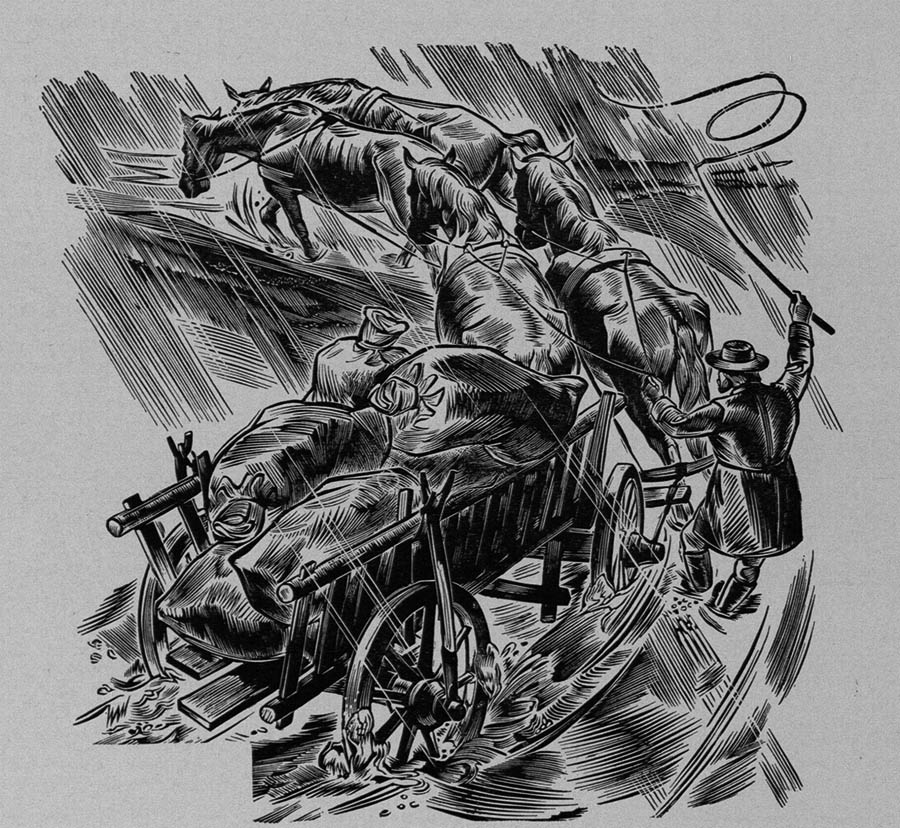
HORSE TEAM IN AUTUMN
Wood engraving, 1936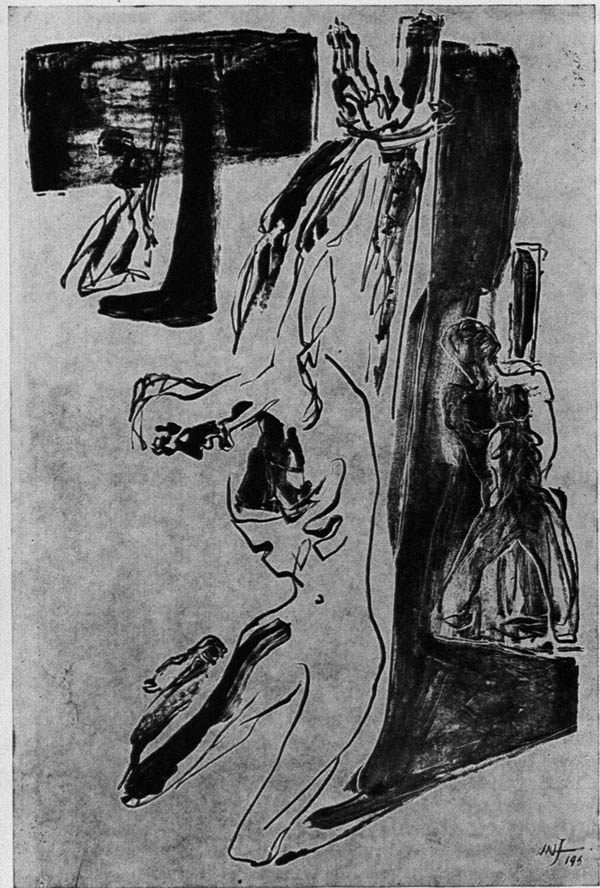
LITHUANIAN FREEDOM FIGHTER
Lithograph, 1951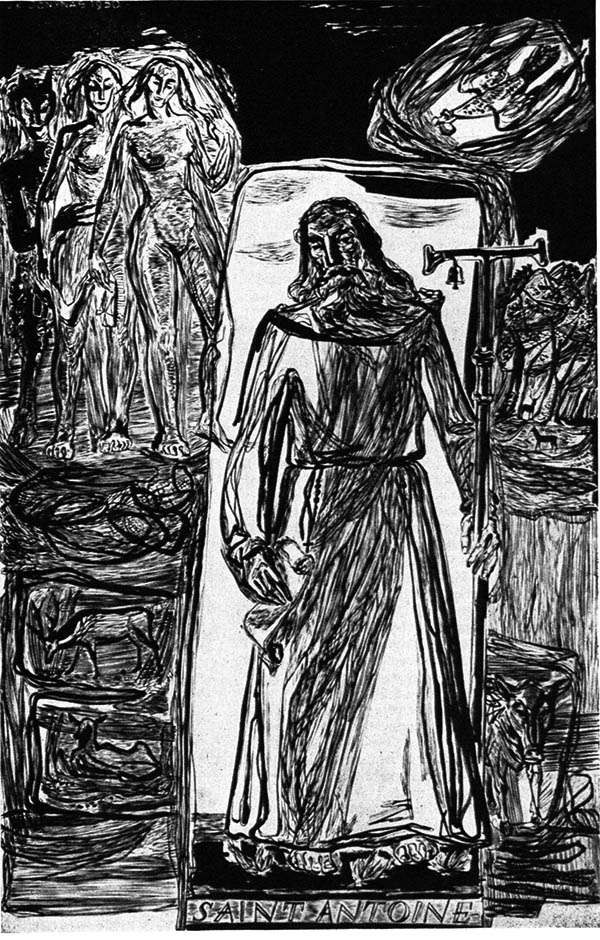
THE TEMPTATION OF SAINT ANTHONY
Wood engraving, 1949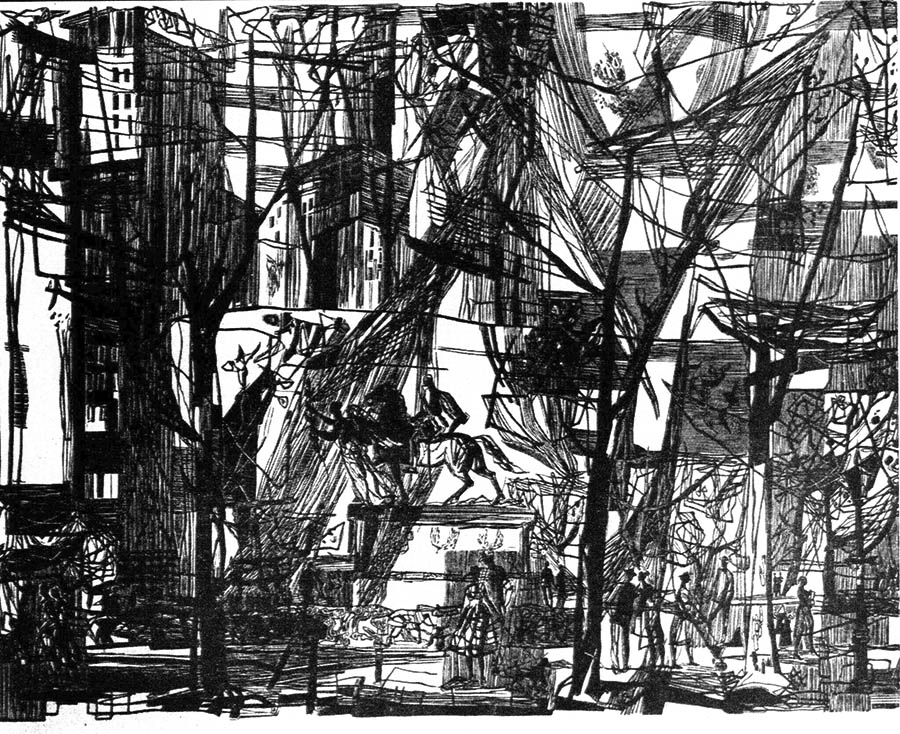
FIFTH AVENUE
Wood engraving 1957
Medal of Honor of Audubon Society and John Taylor Arms award, 1958.
Print Club of Philadelphia award, 1958. Accquired by Philadelphia Museum of Arts and Library of Congress.
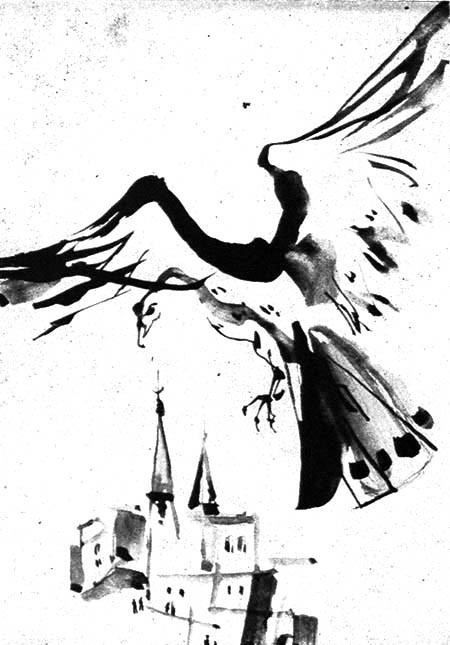 | 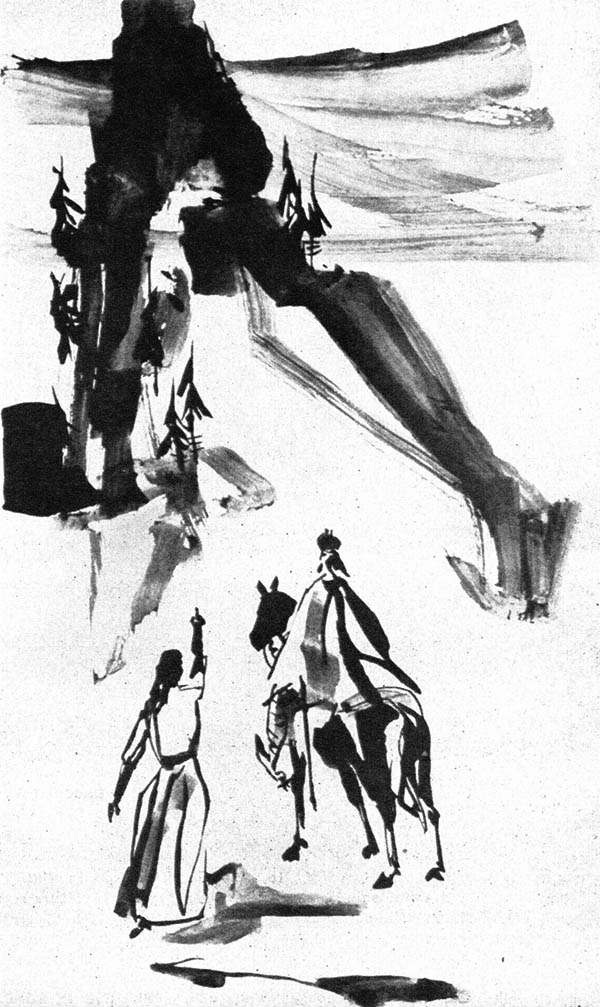 |
| ILLUSTRATION for the "Golden Slipper" by A. Vaičiulaitis India Ink drawing, 1956 | |
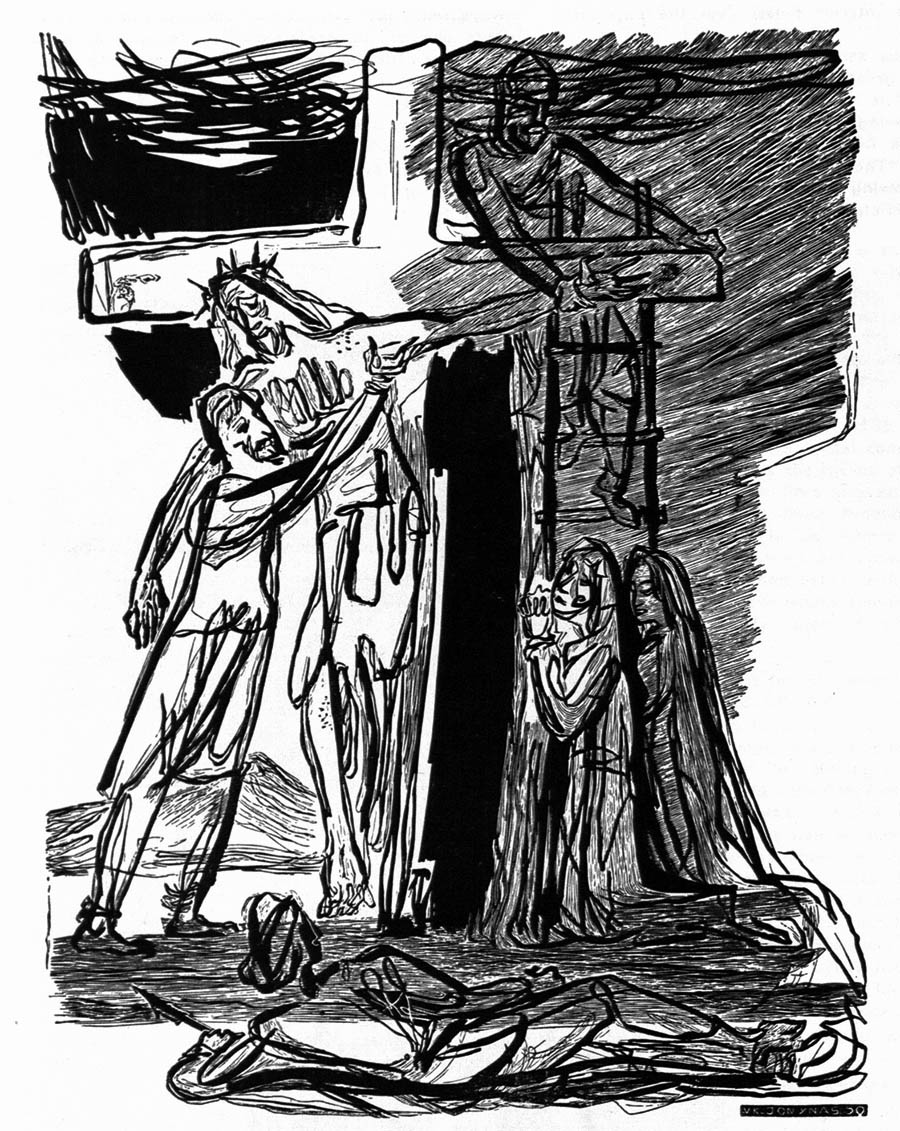
DESCENT FROM THE cROSS
Wood engraving, 1950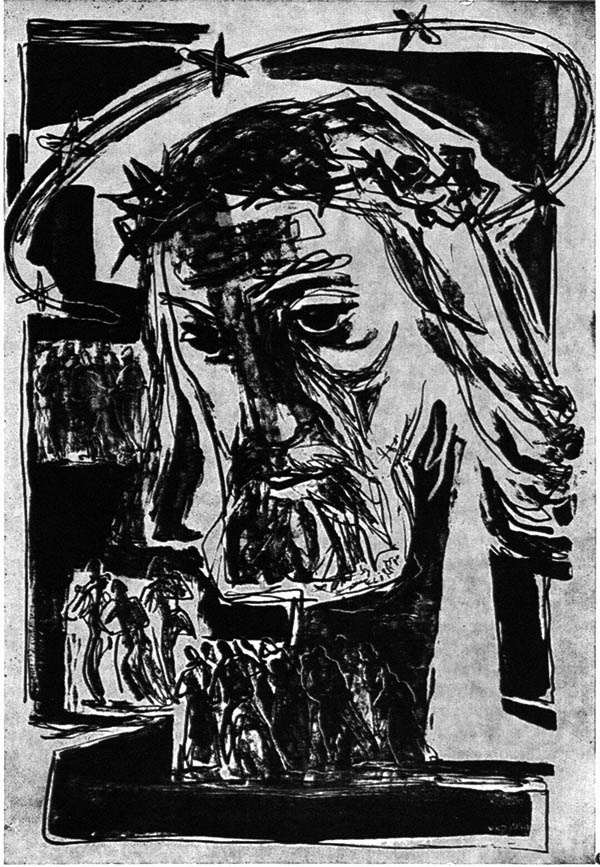
HEAD OF CHRIST
Lithograph, 1951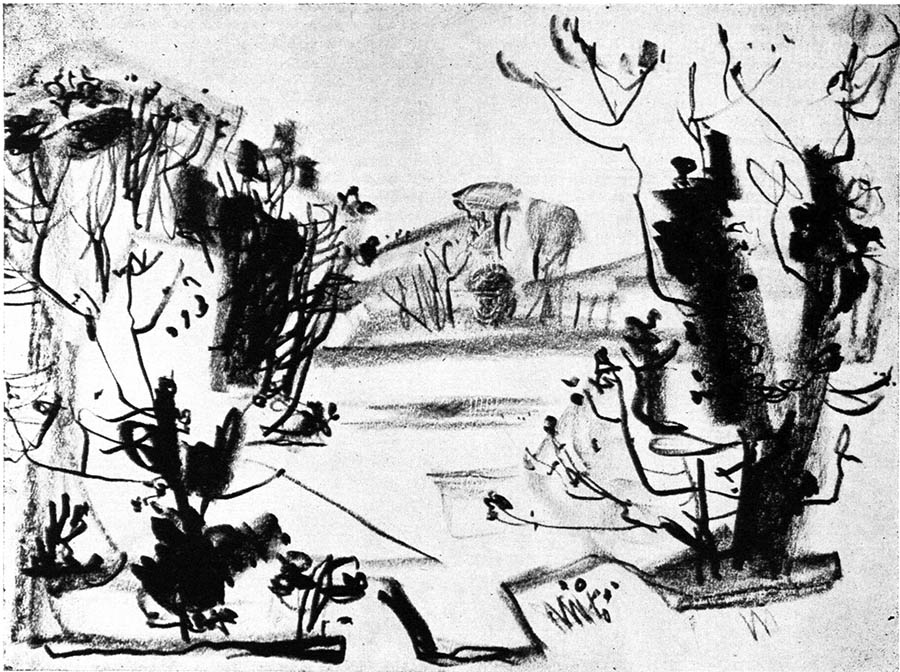
LANDSCAPE
Pencil Drwaing, 1953